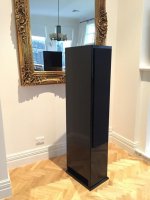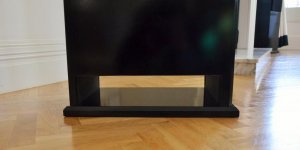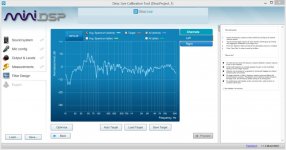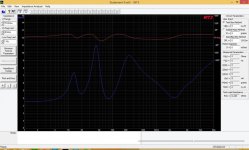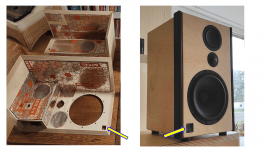EDIT: Moved from "System pictures & description" thread as discussion arised.
Hello everyone,
i may introduce my latest speaker to you:
Name: "Schnuckelchen" (= german for sweetheart, darling...)
Hi: Bliesma T25A-6
Mid: Kartesian Mid120_vHE
Lo: SB Satori WO24P-4 @ 24l CB
Amps/DSP: Hypex FA503




Drivers integrated in enclosure driven by FA503 +/- 90° hor and ver, measurement distance 1,5m, calibrated mic, 0° responses of woofer and midrange merged with nearfield response + enclosure simulation:

Resulting xover / filtering, optimized for +/-60° hor +/-40° ver power response:

Best regards
Peter
Hello everyone,
i may introduce my latest speaker to you:
Name: "Schnuckelchen" (= german for sweetheart, darling...)
Hi: Bliesma T25A-6
Mid: Kartesian Mid120_vHE
Lo: SB Satori WO24P-4 @ 24l CB
Amps/DSP: Hypex FA503
Drivers integrated in enclosure driven by FA503 +/- 90° hor and ver, measurement distance 1,5m, calibrated mic, 0° responses of woofer and midrange merged with nearfield response + enclosure simulation:
Resulting xover / filtering, optimized for +/-60° hor +/-40° ver power response:
Best regards
Peter
Last edited:
Hello Peter,
Thanks for posting your measurements, your results on the Kartesian MID120vHe corroborate mine (I did them inside on a +/- 180° at 1m.
You, very wisely, choose 2500Hz for the cut-off frequency ! I was hoping to be able to cover up to 3kHz but strong anomalies at 4 kHz and up made this impossible (at least for me)
Thanks for posting your measurements, your results on the Kartesian MID120vHe corroborate mine (I did them inside on a +/- 180° at 1m.
You, very wisely, choose 2500Hz for the cut-off frequency ! I was hoping to be able to cover up to 3kHz but strong anomalies at 4 kHz and up made this impossible (at least for me)
Looks great Peter It doesn’t get much better than that!Name: "Schnuckelchen" (= german for sweetheart, darling...)
Hi: Bliesma T25A-6
Mid: Kartesian Mid120_vHE
Lo: SB Satori WO24P-4 @ 24l CB
Amps/DSP: Hypex FA503
View attachment 1046776 View attachment 1046777
View attachment 1046778
View attachment 1046782
Drivers integrated in enclosure driven by FA503 +/- 90° hor and ver, measurement distance 1,5m, calibrated mic, 0° responses of woofer and midrange merged with nearfield response + enclosure simulation:
View attachment 1046779
Resulting xover / filtering, optimized for +/-60° hor +/-40° ver power response:
View attachment 1046780
Best regards
Peter
Have you looked at the thread regarding ideal cabinets shapes using Vituixcad modelling?
I’ve often wondered if using facets would smooth out HF responses. And more importantly, to the point where it would lead to audible improvements.
Looks great Peter It doesn’t get much better than that!
Have you looked at the thread regarding ideal cabinets shapes using Vituixcad modelling?
I’ve often wondered if using facets would smooth out HF responses. And more importantly, to the point where it would lead to audible improvements.
Thanks!
Of course with facets, radius, waveguides, organically shaped baffles e.g. you could smooth out the response and furthermore shape the overall directivity.
Arrangement of mid and tweeter was optimized by Basta! baffle simulation, design pattern of geometrics is orientated on golden ratio. I did some analyses here in simulation, and if you are restricted to a simple rectangular baffle this is the best arrangement I found.
but...
1) It depends on your woodworking skills and possibilities. I'm moderatly talented with my hands and have no workshop, garage or similar at home. I order the byrch plywood panels ready cutted and milled according to my CAD drawings from CNC carpenter service and just glue them together on the kitchen table. Sanding, waxing --> finalized. So I'm kind of restricted here with the shape of the speakers.
2) Speakers are also furniture, they have to look nice and must optically integrate in my living room. And me and my wife love that "scandinavian techno style", that's how a speaker has to look for me; a simple cuboid made of bright wood. A large radius would of course smooth out the tweeter response, but I won't like how it looks...
I once applied wide aluminum profiles with r=45mm to another speaker of me which had positive effect on smoothness especially to the responses of wider angles:
With profiles:
Without profiles --> more ruggy:
The only necessary change between the tunings/filtering due to different baffle was very little rise in the response at ~1kHz to be compensated:
Did I hear a difference? Honestly no, but obviosly I did no 1 by 1 comparison.
The profiles looked a bit bulky and the speakers were to wide for the actual placing in my home office, so i dismounted them again. But without I missed something, so I applied smaller profiles just for optics. Now they look finalized and appealing to me. For "Schnuckelchen" I just copied that style:
With waveguides, horns, cardioids e.g. you aim for constant directivity, with my simple baffle configurations I archieve power response approaching "Zwicker-Curve" which also sounds very nice for my taste in acoustically non-treated living rooms:
Inverted Zwicker-Curve (purple) and "Schnuckelchen" directivity index (red):
Explanation, translated via deepl from german diy hifi forum:
kwesi: First of all, the curve describes following as a "thought experiment": You take an ideal point source as a loudspeaker, which radiates ideally spherically in all directions. You smooth out the free field frequency response (i.e. in an ideal anechoic chamber, 5 km in the air or similar) and listen to the "loudspeaker" in this environment without room influences; so you only hear what really comes directly from the loudspeaker to your ears. Then you put the point source into an ideal reverberation chamber (reverberation radius --> 0), sit in front of it again and listen with all reflections from all sides. The same LS or the sound field now seems to be too loud at 1kHz, too quiet at 3kHz and so on. If you now implement the Zwicker curve in the equalizer before the LS, it sounds again as "neutral" as if you listen without room influence.
JFA: The curve is valid only in an ideal free field and an ideal diffuse field, i.e. exactly the spaces described by Peter above. And that's where it starts: a free field can be imagined quite well (hint: it is not a free field), but a diffuse field is more difficult. Such a diffuse field contains no more spatial information, because the sound hits the ear from all sides with random phase positions. So we would not be able to localize a sound source in a diffuse field. In real existing listening rooms this is of course not true, there is always something like locatability. So there is never a real diffuse field. So the curve as it stands there is not valid, but the further you sit away from the loudspeakers, the larger the part of the diffuse field becomes, and the more you approach this curve. Depending on the intended listening situation, the loudspeakers have a more uniform directivity or one that is closer to the Zwicker curve.
Source: https://www.diy-hifi-forum.eu/forum...empfinden-Zielkurve-und-B%FCndelungsverhalten
Best regards
Peter
P.S.: if there are arising too many discussions here, the moderation may move this to a separate thread...
Last edited:
Measurements are great but how does it sound? Does it impart a natural real life quality to the sound that gives you the you are there feeling or does it sound like a speaker in a box? The ability to disappear is more important than flat frequency response. How well does it recreate the original recording?
Measurements are great but how does it sound? Does it impart a natural real life quality to the sound that gives you the you are there feeling or does it sound like a speaker in a box? The ability to disappear is more important than flat frequency response. How well does it recreate the original recording?
Of course I can only speak about the system sound together with the room response and not the midrange separated, and only for my taste:
The sound detaches from the speakers immediately and spans very far beyond the LS in all directions, all sources placed by the sound engineer are very neatly arranged. It appears very clear and "real". This happens unusually compellingly, probably due to the very wide dispersion. So the ability to "disappear" as you mentioned is very distinctive. (I'm convinced this is not more important, but directly related to a flat frequency response and targeted power response ;-) )
The speakers can also play surprisingly loud for their size, but bass first limits by woofer's maximum excursion capability. Up to that point, however, no compression or like can be heard, the sound doesn't collapse. Mid-highs can even play more dynamically and let it subjectively more "bang" than a combination of 18Sound 8NMB420 and Satori TW29DN with significantly more membrane surface, sounds very "live" and dynamically but never getting harsh.
Yesterday evening I listened to a Foo Fighters live concert recording kicking at yet elevated levels with a big smile on my face, so I'm happy and satisfied with the result. I'm sure the mid-high unit can also be matched with a 10" PA woofer 100-300 Hz and additional 15" Sub without getting overstrained, especially that combination T25A / Mid120_vHE performs astonishing good...
Best regards
Peter
Last edited:
Hi Peter,
Thanks for your thoughtful and detailed response. I'm at a stage of speaker design where I WANT to do some empirical testing for round-overs/facets etc vs square edges, it's probably the lowest hanging fruit to improve my designs. (I already have all the tools and 2 identical test boxes I just need to find the time to do it).
My main reluctance is because I'm not convinced that I can hear differences, in my room, between my speakers WITH and WITHOUT, even though they make large differences in measurable responses, particularly in frequencies that the ear is ought to be more sensitive.
Depending on the speakers I'm cognizant that I may prefer to listen to one with grills on or without, I want to listen to them without grills (I may find the cabinet/tweeter attractive on another speaker) so there's definitely an element of visual distractor/attractor to psychoacoustics.
I showed my wife cabinets like Vivid Audio and Estelon and she didn't like the look of either.
The last big tall floorstander that I assembled, (before I started designing my own), was Jim Holtz/Curt Campbell's Statement II WMTMW (8"/4"/ribbon).
It had a 45 degree bevel and sounded terrific. If it didn't have bevels... it would probably still sound terrific...
http://www.htguide.com/forum/showthread.php?41927-Statements-II-A-musical-evolution/page2
Thanks for your thoughtful and detailed response. I'm at a stage of speaker design where I WANT to do some empirical testing for round-overs/facets etc vs square edges, it's probably the lowest hanging fruit to improve my designs. (I already have all the tools and 2 identical test boxes I just need to find the time to do it).
My main reluctance is because I'm not convinced that I can hear differences, in my room, between my speakers WITH and WITHOUT, even though they make large differences in measurable responses, particularly in frequencies that the ear is ought to be more sensitive.
Depending on the speakers I'm cognizant that I may prefer to listen to one with grills on or without, I want to listen to them without grills (I may find the cabinet/tweeter attractive on another speaker) so there's definitely an element of visual distractor/attractor to psychoacoustics.
I showed my wife cabinets like Vivid Audio and Estelon and she didn't like the look of either.
The last big tall floorstander that I assembled, (before I started designing my own), was Jim Holtz/Curt Campbell's Statement II WMTMW (8"/4"/ribbon).
It had a 45 degree bevel and sounded terrific. If it didn't have bevels... it would probably still sound terrific...
http://www.htguide.com/forum/showthread.php?41927-Statements-II-A-musical-evolution/page2
Attachments
😵 And yes, before you ask, that IS a DIY wall mount, with adjustable toe-in, for a 100+ lb speaker.
That was my living room speakers from 2015-2018, before I moved to Canada. And I time when I had young children and my spouse was concerned about that they would climb or push/pull the TV/speaker and be injured from falling appliances. She's a physician so she's seen it all too many times...
That was my living room speakers from 2015-2018, before I moved to Canada. And I time when I had young children and my spouse was concerned about that they would climb or push/pull the TV/speaker and be injured from falling appliances. She's a physician so she's seen it all too many times...
Last edited:
I'm at a stage of speaker design where I WANT to do some empirical testing for round-overs/facets etc vs square edges, it's probably the lowest hanging fruit to improve my designs. (I already have all the tools and 2 identical test boxes I just need to find the time to do it).
Here is some research results to that question:
https://heissmann-acoustics.de/en/kantendiffraktion-sekundaerschallquellen-treiberanordnun/
Best regards
Peter
Thanks Peter,
Yes I’ve previously read this. I’m a fan of Alexander’s work, but not yet listened to any of his creations.
I’m looking for well controlled studies eg. double blind trials to establish an audible benefit or difference.
Yes I’ve previously read this. I’m a fan of Alexander’s work, but not yet listened to any of his creations.
I’m looking for well controlled studies eg. double blind trials to establish an audible benefit or difference.
2) Speakers are also furniture, they have to look nice and must optically integrate in my living room. And me and my wife love that "scandinavian techno style", that's how a speaker has to look for me; a simple cuboid made of bright wood. A large radius would of course smooth out the tweeter response, but I won't like how it looks...
I really like your big speakers and am with you on the above comment. 👍 My own "big" speakers are black 15" bass and 14" waveguide (TD15M + QSC) on a natural BB-ply enclosure, somewhat yellowed due to the wipe-on poly finish. While they are bi-amped with a DSP crossover, the next step would be to integrate it to the speaker like you did, to reduce the visual clutter of boxes and cables. Designing and building a 3-way is also something I'd like to do, but I have no need or space for that at the moment.
Peter - very nice work. 😎
On the rear of the cabinet, there is an oval hole, which appears to open into the amplifier enclosure. Is this for additional air venting, or is it a handle to lift the cabinet? both?
Also, there is a small square cutout on the front baffle under the woofer. I marked it in my graphic. What is this for?
I wonder if you could share your thoughts on selecting the FA503 for this project. It is the most powerful and most expensive of the hypex amps, so you probably had a specific reason for choosing it over the FA253... ?
Thanks, and again, very nicely done !
Jim
On the rear of the cabinet, there is an oval hole, which appears to open into the amplifier enclosure. Is this for additional air venting, or is it a handle to lift the cabinet? both?
Also, there is a small square cutout on the front baffle under the woofer. I marked it in my graphic. What is this for?
I wonder if you could share your thoughts on selecting the FA503 for this project. It is the most powerful and most expensive of the hypex amps, so you probably had a specific reason for choosing it over the FA253... ?
Thanks, and again, very nicely done !
Jim
Attachments
Jim,
there was some space left above the amplifier module so I decided to have a handle there to carry the speaker around. Additionally the opening helps to vent the amplifier that the fan stays off and quiet.
The cutout on the baffle is for the Hypex remote receiver:
https://www.hypex.nl/product/fusion-remote-kit/163
The FA503 is much oversized, but I already had it from a previous project. The FA253 would be more than sufficient, as the FA123 may be a bit too weak.
Did some analysis of the achievable sound pressure in simulation:

Actually the system maximum sound pressure is limited by the woofer excursion capabilities in the low bass range - but I plan to add two 12" CB long stroke subwoofers to support the speakers < 80Hz in future to overcome that. Placing in my living room may be inspired by this study from Harman:

https://www.harman.com/documents/multsubs_0.pdf
We bought an apartment the year before last - the living room with open kitchen area is large and beautiful, but unfortunately completely unsuitable to put a "classic TV/HiFi wall" opposite the sofa without either of them standing around in the middle of the room (which we don't want). We then decided that the TV would go in a small guest room. For an "official" sound system in the living room I then built exactly 1 year ago these two "washing machines" here:

In the long run, we're annoyed that we often have to watch TV in the small room in the evenings - we have therefore decided that the TV has to go back into the living room.
The requirements were
After some discussions and considerations the following was decided:


Unfortunately, the "washing machines" have to go with a few tears in my eyes...
I'll just reused the FA503 for the "Schnuckelchen", and the "old" speakers will get connection use in a party PA for our neighborhood (mid and tweeter to be replaced by 2" compression driver with horn)
"Schnuckelchen" therefore has a difficult legacy, especially in terms of maximum sound pressure...
I have selected drivers that allow quite high sound pressure levels for their size and type due to their very good magnet systems with very low distortion.
Best regards
Peter
there was some space left above the amplifier module so I decided to have a handle there to carry the speaker around. Additionally the opening helps to vent the amplifier that the fan stays off and quiet.
The cutout on the baffle is for the Hypex remote receiver:
https://www.hypex.nl/product/fusion-remote-kit/163
The FA503 is much oversized, but I already had it from a previous project. The FA253 would be more than sufficient, as the FA123 may be a bit too weak.
Did some analysis of the achievable sound pressure in simulation:
Actually the system maximum sound pressure is limited by the woofer excursion capabilities in the low bass range - but I plan to add two 12" CB long stroke subwoofers to support the speakers < 80Hz in future to overcome that. Placing in my living room may be inspired by this study from Harman:
https://www.harman.com/documents/multsubs_0.pdf
We bought an apartment the year before last - the living room with open kitchen area is large and beautiful, but unfortunately completely unsuitable to put a "classic TV/HiFi wall" opposite the sofa without either of them standing around in the middle of the room (which we don't want). We then decided that the TV would go in a small guest room. For an "official" sound system in the living room I then built exactly 1 year ago these two "washing machines" here:
In the long run, we're annoyed that we often have to watch TV in the small room in the evenings - we have therefore decided that the TV has to go back into the living room.
The requirements were
- Screen and speakers left/right next to it should be arranged as the current system.
- The arrangement must be capable to be twisted 90° and aligned to the sofa within a few seconds
After some discussions and considerations the following was decided:
Unfortunately, the "washing machines" have to go with a few tears in my eyes...
I'll just reused the FA503 for the "Schnuckelchen", and the "old" speakers will get connection use in a party PA for our neighborhood (mid and tweeter to be replaced by 2" compression driver with horn)
"Schnuckelchen" therefore has a difficult legacy, especially in terms of maximum sound pressure...
I have selected drivers that allow quite high sound pressure levels for their size and type due to their very good magnet systems with very low distortion.
Best regards
Peter
Nice work! What made you decide on the Kartesians and do they live up to expectations? And glad to see Basta! still is in use.
Nice work! What made you decide on the Kartesians and do they live up to expectations? And glad to see Basta! still is in use.
I was looking for a small, high qualitiy <= 4" midrange to match the wide dispersion of the tweeter.
Additionally it should be capable to produce high sound pressure with low distortion - so high sensitivity and strong and linear magnet system was desired. I was sneaking around the new 3" Bliesma domes initially, but they were over budget and not really matching the overall concept. So I searched for cone drivers within that specification, especially ones that are also capable to take high electrical power with a voice coil larger than the usual 25 mm diameter.
I found three drivers matching these requirements:
- Scan Speak 12MU/4731T00
- Kartesian Mid120_vHE
- B&C 4NDF34
The 12MU and Mid120 play in the same ballpark, but the Kartesian is ~180.-€ and the Scan Speak ~300.-€.
The B&C is cheap ~50.-€ but ugly and the Kartesian has a bit better specs, so it was decided and I don't regret the choice, as written before:
Especially that combination T25A / Mid120_vHE performs astonishing good...
Hello Peter,
Thanks for posting your measurements, your results on the Kartesian MID120vHe corroborate mine (I did them inside on a +/- 180° at 1m.
You, very wisely, choose 2500Hz for the cut-off frequency ! I was hoping to be able to cover up to 3kHz but strong anomalies at 4 kHz and up made this impossible (at least for me)
This is the equalization I applied:
If you want to run them up to 3kHz you may need very steep xover:
2,5kHz is much better to handle and also better for vertical directivity.
Best Regards
Peter
Nice speaker Peter!
Could you tell me who did it for you?I order the byrch plywood panels ready cutted and milled according to my CAD drawings from CNC carpenter service and just glue them together on the kitchen table.
Wow, why did you not just drill a hole for the light pipe?The cutout on the baffle is for the Hypex remote receiver:
https://www.hypex.nl/product/fusion-remote-kit/163
Interesting design. As far as the calibration curve concerns, its similar to the usual Fletcher Munson curve. I use a modified version of this - ie high Q +1.5 dB @ 1k, low Q -2 to -3 dB @ 3k, mid Q +1.5 to 2 dB @ 10k and a high Q -1.5 to -2 dB @ 8k. This amount of EQ factors in a mean listening level of 80 - 90 dB. The curve deviates considerably at different SPLs.
The reduction at 8k is very important, as its a natural resonance im most people's cochlea that can cause early listening fatigue. The 3k reduction is also very important, because its the natural lift in our hearing curve that has adapted to human speech, specifically to babies crying and kids screaming. The preferred center of that dip can range from 2.5k to 4k, depending on the person, mainly governed by the shape of their ears.
The reduction at 8k is very important, as its a natural resonance im most people's cochlea that can cause early listening fatigue. The 3k reduction is also very important, because its the natural lift in our hearing curve that has adapted to human speech, specifically to babies crying and kids screaming. The preferred center of that dip can range from 2.5k to 4k, depending on the person, mainly governed by the shape of their ears.
The only measurements I know are from the manufacturer website:Have you seen or taken any distortion measurements of the driver?
https://www.kartesian-acoustic.com/copie-de-twt30-vms
Despite my mic is calibrated for FR, it is known to have too much own distortion to trust distortion measurements (Monacor ECM-40)
https://www.dabenmo.de/Could you tell me who did it for you?
Wow, why did you not just drill a hole for the light pipe?
They have 2,5D CNC mill and manufacture according to technical drawings:
The set of machined 18mm birch plywood plates for both speakers was ~250.-€ plus shipping ~20.-€
and it was not that much efford for me to put the cutout for the IR receiver onto the drawing additionally 😉
Interesting design. As far as the calibration curve concerns, its similar to the usual Fletcher Munson curve. I use a modified version of this - ie high Q +1.5 dB @ 1k, low Q -2 to -3 dB @ 3k, mid Q +1.5 to 2 dB @ 10k and a high Q -1.5 to -2 dB @ 8k. This amount of EQ factors in a mean listening level of 80 - 90 dB. The curve deviates considerably at different SPLs.
The reduction at 8k is very important, as its a natural resonance im most people's cochlea that can cause early listening fatigue. The 3k reduction is also very important, because its the natural lift in our hearing curve that has adapted to human speech, specifically to babies crying and kids screaming. The preferred center of that dip can range from 2.5k to 4k, depending on the person, mainly governed by the shape of their ears.
I think we talk about different approaches here, as you apply the equalizing to the on axis and overall FR; e.g. 3k reduction is also known as "BBC-dip" to me which makes the sound softer. I sometimes use this for bad recorded metal music to make it herable...
I try to get flat on axis FR for direct sound, but with increasing angle approaching "Zwicker-Curve" to influence indirect sound / diffuse reflections because to me this sounds more real and clear in acoustical untreated and rather reverbant environments.
Best regards
Peter
- Home
- Loudspeakers
- Multi-Way
- Schnuckelchen | T25A-6 | Mid120_vHE | WO24P-4 | FA503
